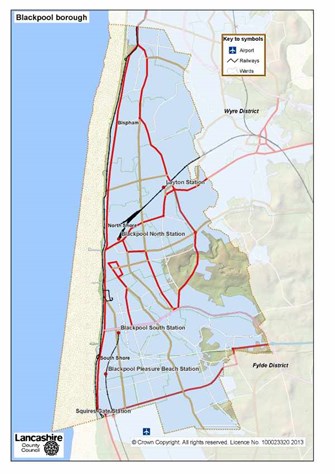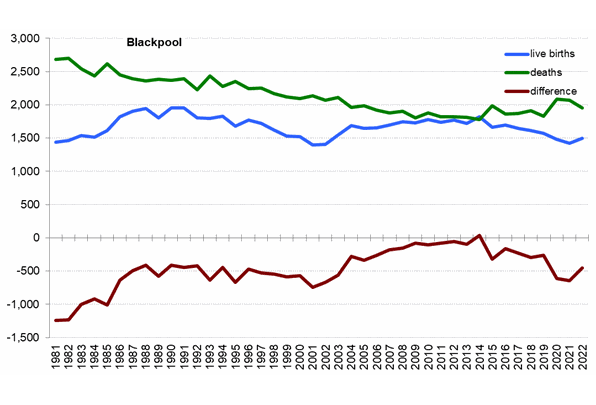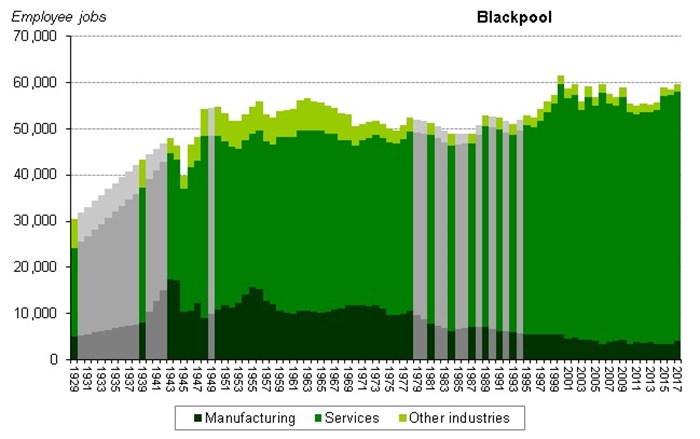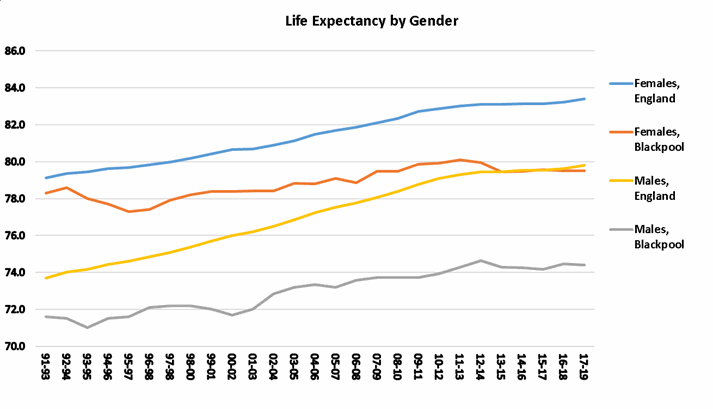Blackpool unitary
This summary offers a snapshot of some of the most important economic, social and environmental factors in Blackpool unitary authority with links through to the source information. The information has been allocated to one of seven themes: 
- Children and Young People
- People and Communities
- Economic Development
- Community Safety
- Environment and Transport
- Health and Wellbeing
- Older People
Introduction
Blackpool is a well known Lancashire coastal resort. In geographic terms it is by far the smallest Lancashire authority covering just 35 square kilometres, has 21 wards for which Census 2021 profiles are available. These appear as starter pages showing just the population, but around 30 Census topics can be added. The number of people per km² is more than ten times the England and Wales average. From an historic point of view there have been dramatic changes and the pace of future change is liable to increase.
The GOV.UK web page on schools performance lists the 56 schools in Blackpool. Of these 40 are primary and 17 are secondary (one is for ages 3 to 16). Key stage 4 covers the two years of school education that incorporates GCSEs in maintained schools. In 2016 a new secondary school GCSE accountability system was implemented, in which 'Attainment 8' measures achievement in maths and English plus other subjects with less weighting. By this new measure the average score for Blackpool in 2021/22 was 38. This was the lowest percentage among the 14 local authorities in the broader Lancashire area, and the lowest in England (apart from the City of London which has just 11 schools and a non-standard population). As the pandemic affected different areas unequally, this is too soon to place great emphasis on this result. The Department for Education achievement and attainment tables have more information on achievement at other levels.
Only a relatively small number of families in Blackpool have an income level that led to them opting out of receiving child benefit.
The population of the authority in 2022 was 141,574, and has largely been in decline since 2006. One of the first Census outputs made available is an interactive tool that compares the 2021 results with 2011 for local authorities. As would be expected in a coastal authority, there is a bias towards a higher percentage of people of retirement age. The total fertility rate in Blackpool was 1.65 in 2021 and has fallen appreciably since 2016, when it was 2.09, but was still above the national average (1.55).
Local authority live births and deaths graphs are available that track changes in births and deaths since the 1980s for each authority in Lancashire. The graph for Blackpool reveals how the gap between the numbers of births and deaths was closing until 2014 since when they have diverged. Because of the Covid-19 pandemic most districts, including Blackpool, had more deaths than births in 2020, 2021 and 2022. The number of deaths in each month of 2023 can be seen in the monthly mortality graph slide on the Lancashire Insight Covid-19 intelligence web page.
Insight Covid-19 intelligence web page.
It was projected that between 2018 and 2026 the population of Blackpool will actually decrease by -0.3%, and after that will have transformed into a very modest 1.6% increase by 2043. This is in contrast to the 7.2% increase expected over the 25 year period of the projections for the Lancashire 14-authority area and the England growth figure of 10.3%. The projected number of households in the authority is predicted to grow by 4.3% between 2018 and 2043. We think this to be unlikely, as there is very little land available in Blackpool for development. It is still the lowest projected rate of change in households for the Lancashire-14 area and is not as high as the % rise predicted in the 2014 base projections, yet is well above the rise predicted in the 2016 base projections.
The median house prices to earnings is relatively low in the authority.
Blackpool has high proportions of its housing stock in the lowest two council tax bands (A and B). It maintains a proportion of its dwelling stock in local authority sector and has only a small percentage provided by registered social landlords. The authority also has a high percentage of vacant dwellings. The total number of dwellings has recovered since 2016/17 when the net additional dwellings figure was negative.
In Blackpool, 20.2% of households were estimated to be in fuel poverty in 2021. This is the highest percentage of fuel poor in Lancashire and also has the largest number of households that are fuel poor. The authority was ranked the 6th worst in England out of 296 local authorities. The main factors that determine this are the energy efficiency status of the property, the cost of energy, and household income.
The 2019 Indices of Multiple Deprivation revealed Blackpool was ranked the most deprived area out of 317 districts and unitary authorities in England, when measured by the rank of average LSOA rank and also by two of the other four measures. In total, 39 (41.5%) of the lower super output areas in the authority were among the 10% most deprived in the country, of which 8 were also in the top 10 most deprived neighbourhoods in England.
Gross value added is a measure of economic activity, and the 2016 result for Blackpool revealed a per head of population figure that was just 63.1% of the UK average.
Employee numbers in Blackpool decreased in the decade to 2008, and between 2009 and 2017 employment in the authority declined but has recovered to the same level. The authority has a high reliance on public-sector employment which has been under pressure over recent years. 36% of all Civil Service jobs in the Lancashire-14 area are based in Blackpool. Our extensive employment records allow us to monitor the changes to employee numbers from 1929 onwards. We have published separate graphs for each of the 14 Lancashire local authorities that reveal changes in total employee numbers and the shift from manufacturing to service sector employment. Methodological changes, and assumptions for missing years, reduce the accuracy of the graphs, but they do give a useful broad indication of changes over time. The graph for Blackpool is displayed below and reveals a relatively stable overall number of jobs since around 1950 onwards.

As a major tourist destination Blackpool has always had a lower than average rate of employee jobs in the manufacturing sector, and therefore a much greater reliance on service sector employment. as expected, the authority is well-represented in the employment sector of arts, entertainment, recreation and other services.
The Blackpool Business Improvement District website includes monthly visitor economy performance reports. They include figures on footfall, resort pass sales, car park ticket sales, plus tram passenger numbers etc.
Another part of the service sector that is a major source of employment in Blackpool, and the wider Fylde coast is public administration. The annual civil service employment survey emphasises the vital role that Civil Service employment still has in Blackpool. In 2018 at 4,820 full and part-time employees, Blackpool was the base for 36% of Civil Service staff employed in the Lancashire NUTS 2 area.
In 2023 there were 4,150 active enterprises in Blackpool, 7.2% more than in 2022. 88.2% have fewer than ten employees. around 400 are in the small (10-49 employees) category, and 20 have over 250 employees. Blackpool does see a rapid turnover of businesses because a strong local visitor economy can often lead to high levels of business births and deaths.
The 2011 census revealed that there are strong commuting flows between the three Fylde Coast authorities of Fylde, Wyre and Blackpool.
The UK government properties database is a searchable list of all UK government property holdings and land assets. The web page for the North West region lists land and properties by towns including those in Blackpool.
The most recent companies in Blackpool to win a King's Award for Enterprise (previously Queen's Award) are Floss and Rock in 2023, Chelsom Ltd. in 2020, MacUK Neuroscience Ltd, in 2011 and T.I.S.S. Limited in 2014 and 2018. The latter award for T.I.S.S is in the 'Innovation' category.
Gambling forms part of the visitor economy and the gambling commission website contains licensing authority returns by local authority area for the past few financial years. Blackpool has by far the largest number of permits (around 460) in the 14-authority Lancashire area, though some of these are of the amusement arcade type. Information on the individual premises is now held and disseminated by the relevant local authority.
Assisted areas are those places where regional aid can be offered to undertakings, typically businesses, under European Union state aid rules. From 2014 to 2020 Blackpool had 11 wards with assisted area status. Following the departure of the UK from the European Union, these rules no longer apply, but a Subsidy control bill is currently going through Parliament.
The authority has a history of low overall employment rates in comparison to the national average.
Gross disposable household income is effectively the amount of money that after taxes, social contributions, pensions and housing interest payments, households have available for spending or savings. The figure for Blackpool was lower than the county and UK average. The index figure, placing Blackpool within the UK compared other areas. showed a rapid decline until 2007, then began to recover.
Average earnings in Blackpool are very low when measured by both place of residence, the lowest in Lancashire, and by place of work, second lowest in Lancashire.
The survey of personal incomes by HM Revenue and customs broadly includes all individuals whose income is higher than the prevailing personal tax allowance and who are therefore liable to tax. The median results are the middle value that best reflects typical income and they show a result for Blackpool that is significantly below other Lancashire authorities.
The authority has a very large number of employment and support allowance claimants. Housing benefit recipient numbers are also extremely high in the authority, but the local effect of the spare room subsidy withdrawal appears to be less pronounced than in some other areas of the county. In comparison to the national average, there is a very high percentage of the working age population that is reliant on welfare benefits.
Universal credit is a benefit for people on low income or who are out of work. Numbers are updated on a monthly basis, and the substantial total for Blackpool is higher than any other Lancashire authority.
The personal insolvency rate in Blackpool per 10,000 population is often one of the highest recorded among all the district and unitary authorities in England and Wales, and was fifth highest in 2022.
A pilot project for the Pride of Place programme operated by Business in the Community has begun in the town, with the aim of increasing economic activity and building up the voluntary sector in order to relieve pressure on publicly provided services.
The town centre of Blackpool is destined to benefit from the Future High Streets Fund, launched in 2018, and indirectly from a mix of funding sources which also includes the Future High Streets Fund, but channelled through the High Streets Heritage Action Zones scheme.
In the recorded crime article we see that Blackpool has a very high crime rate that is well in excess of the Lancashire-14 average. See also the LG Inform Quarterly Report on Crime and Disorder by Local Authority.
For more details on community safety in your neighbourhood, please enter your postcode or ward into the window in the Local area community safety statistics web page.
Alcohol is known to contribute to offending behaviour, particularly violence, anti-social behaviour and criminal damage. Residents in the authority are significantly worse than the average for many of the alcohol indicators as detailed on the LAPE (Local Alcohol Profiles for England). The authority has a range of low ranks across a number of indicators.
The number of people killed or seriously injured in road traffic collisions in Blackpool was 120 in 2022.
Each year community safety partnerships (CSPs) undertake strategic assessments to identify priority work areas for the partnership. Plans, detailing these priority work areas and activity to address them are available from Blackpool CSP.
The authority has a very high proportion of workers who have a relatively short commute to work. The 2011 census indicated that 15,851 or a substantial 25.6% of Blackpool's working residents aged 16+ commute less than two kilometres. This is the highest percentage in Lancashire and is in excess of the regional and national averages. The authority also has the highest percentage in the 2-5km category (28.6%).
The Department for Transport website has a table with yearly traffic flow results and gives access to an interactive map that lists the traffic flow numbers at sites in Blackpool. The yearly figures reveal a recent pattern of declining traffic flows in Blackpool. Using sustainable transport modes can significantly improve employment opportunities and life chances. In urban areas the reliance on the car presents problems of traffic congestion and reduced air quality.
Blackpool Airport occupies a site that straddles the border between Blackpool and Fylde districts. It was formerly known as Squires Gate Airport and has an aviation history dating back to 1909. Commercial passenger services from the airport dramatically ceased in mid-October 2014, but a month later the airport reopened to general aviation traffic that included helicopters flights to offshore rigs. From 1st April 2015, Citywing re-commenced flights to the Isle-of-Man, but the company ceased trading in March 2017 ending all scheduled flights from the airport. In November 2015, the government approved the new Blackpool Enterprise Zone that covers the Blackpool airport site.
The 11-mile tram link from south Blackpool (Starr Gate) to Fleetwood provides an important service for both locals and tourists. From the mid-1960s to the early 1990s, the Fylde Coast was the only place left in Great Britain with a street-running public tram service. Growth in traffic congestion, pollution and a focus on safety issues has brought into question the policies of previous generations. The passage of time has confirmed the foresight of those who kept the Fylde Coast route in operation. It reopened in April 2012 after being closed for a major upgrade. The large-scale investment represents a major transport improvement for visitors and residents along the Fylde Coast. The tram system passes through Cleveleys and terminates at Fleetwood. The recent public transport figures reveal that passenger numbers for the Blackpool tram system slumped to just 1.1 million in 2011/12. The economic downturn and closures for upgrades adversely affected the results, but the new investment led to figures of over 4 million passenger journeys for the financial years since 2013/14 and over 5 million from 2016/17 to 2018/19. The Covid-19 pandemic caused another slump down to 1.1 million passengers in 2020/21, and revenues slumped by -71.6% to £1.9 million.
The local rail service is mainly provided by Northern, and the main Blackpool North railway station is one of the county's busiest. Work has now been completed on the electrification of key rail routes between Manchester, Liverpool, Preston and Blackpool. As a result of this no trains ran on the line between Blackpool North and Kirkham from 11th November 2017 to 15th April 2018, and between Blackpool South and Preston from 11th November 2017 to 28th January 2018, but a much more frequent service has been in operation since.
Green belts have been an enduring element of national planning policy. They check the unrestricted sprawl of large built-up areas; prevent neighbouring towns from merging into one another; assist in safeguarding the countryside, preserve the character of historic towns and encourage the recycling of derelict and other urban land. Blackpool has the lowest percentage of land designated as green belt in Lancashire. This figure is not however surprising given the fact that the Blackpool urban area covers a very large part of the authority.
Maps are available that reveal the various rural-urban definitions across Lancashire down to the very small census output area level.
The National Biodiversity Network Gateway acts as a “data warehouse” for biodiversity information, which can be quickly and easily accessed to understand the distribution of particular species in the UK. Much of the local data is supplied by the Lancashire Environment Record Network (LERN), which is hosted by Lancashire County Council. An interactive map on this site shows the extent of the Environmental Record Centre coverage, including the LERN area, and when adding a species using the 'Add to Map' control, records of their sightings are displayed.
Carbon dioxide is the principal greenhouse gas believed to be contributing to global warming. Total carbon dioxide emissions in Blackpool are very low when measured in terms of tonnes per resident. The Department for Environment, Food and Rural Affairs website has the latest air pollution details across the whole of the UK. Because Blackpool is so urbanised, the average level of emissions per square kilometre are higher than the other Lancashire authorities, especially those for particulates. The interactive monitoring network map reveals a large number of sites across the country that include a site in Blackpool. Each monitoring site contains a link to allow users to view the last hour's data. The current levels web page allows comparisons to be made between the constantly refreshed figures for the three Lancashire sites, and the results for all the other monitoring sites across the country. Mortality attributed to poor air quality was better than the county and England averages in 2019. In terms of the latest (2019) particulates emission data, Blackpool was the worst in the Lancashire-14 area. As the authority is completely urban, this comes as no surprise.
The Environment Agency samples bathing water quality between May and September to assess performance. in 2019, Bispham was classified as 'excellent' while Blackpool Central, Blackpool South and Blackpool North were classified as 'good' as well as getting 'Seaside Awards' from Keep Britain Tidy.
The Fylde inshore marine conservation zone covers a site off the Fylde coast and the Ribble Estuary.
The rates of household waste sent for reuse, recycling or composting have in general been improving over the years as sharp increases in Landfill Tax have made the traditional form of Landfill disposal much more expensive. The household waste reuse, recycling and composting rate for Blackpool was 38.4% in 2019/20, a slight decline from the year before. The same article also highlights the consistently high number of fly-tipping incidents recorded in the authority, having the second most in the Lancashire-14 area.
With a health index score of 78.1 in 2020 Blackpool is in 2nd lowest place among English local authorities after Manchester.
Figures for life expectancy at birth reveal that Blackpool had the lowest age for male and female life expectancy in England for the 2013-15 period. The following graph reveals life expectancy changes in the authority by three-year time periods from 1991-93 onwards. The graph emphasises the growing disparities between the Blackpool and national averages and indicates that Blackpool's female value is now following the England male value.

The Blackpool Health Profile, published by Public Health England, reveals that the health of people in the area is much worse than the England average, recording the worst rates for seven indicators.
The Blackpool Teaching Hospitals NHS Foundation Trust provides important care facilities in the general locality. The major local hospital is the Blackpool Victoria.
In July 2022 Integrated Care Boards replaced the much smaller Clinical Commissioning Groups as clinically-led statutory NHS bodies responsible for the planning and commissioning of health care services for their local area, including the majority of the hospital and community NHS services. Together with their associated Integrated Care Partnerships, which includes representatives from the upper tier local authorities responsible for social care and public health, they form Integrated Care Systems (ICS). The single ICS covering the whole of the Lancashire-14 area is the Healthier Lancashire and South Cumbria ICS. That web page has a link to a glossary of the terms used and there is a further explanation on a Kings Fund web page.
The Trauma and Injury Intelligence Group (TIIG) was established to develop an injury surveillance system covering the North West. The Lancashire section includes results for Blackpool Victoria Hospital.
The local government association has produced 'housing, health and wellbeing profiles' for each local authority across the country. The figures go down to the ward level, and the Blackpool profile has results from the census, the index of multiple deprivation and other data sources.
Public Health England has produced Cardiovascular disease profiles for each of the former clinical commissioning groups in England, in this case NHS Blackpool CCG, which had the same area as the local authority. There are separate reports for heart disease, stroke, diabetes and kidney disease.
It has been well documented over recent years that people are living longer and that the older age-groups will record some dramatic increases over future years, with associated financial implications and demand for health and social care services. The population aged 65 or over in Blackpool is projected to increase to 35,771 by 2043.
Blackpool has a large number of State Pension claimants, third behind Wyre and Lancaster within the Lancashire-14 area. Pension Credit is for pensioners whose income falls short of the full State Pension amount and the caseload and beneficiary total in the authority is by far the highest in Lancashire.
Attendance Allowance provides financial help to people aged 65 or over who are physically or mentally disabled. The caseload in Blackpool for November 2021 (4,160) is the second largest among the 14 Lancashire local authorities, after Wyre.
Life expectancy as mentioned earlier is increasing but there is no guarantee that the extra years of life will necessarily equate to extra years of healthy life expectancy. However, it is not a foregone conclusion that "extra" years of life expectancy should necessarily lead to additional years with ill health or disability. More suitable community services to enable independent living and more effective practice of preventive lifestyles and medicine has the potential to lengthen disability-free life expectancy, particularly in the case of the prevention and treatment of non-fatal but disabling diseases.
The Lancashire Care Homes Association is an organisation that represents care providers across the broader Lancashire area. The website lists a large number of care and nursing homes, along with domiciliary care agencies in the area. The details are listed by major urban localities across the county.
Page updated 2 April 2024